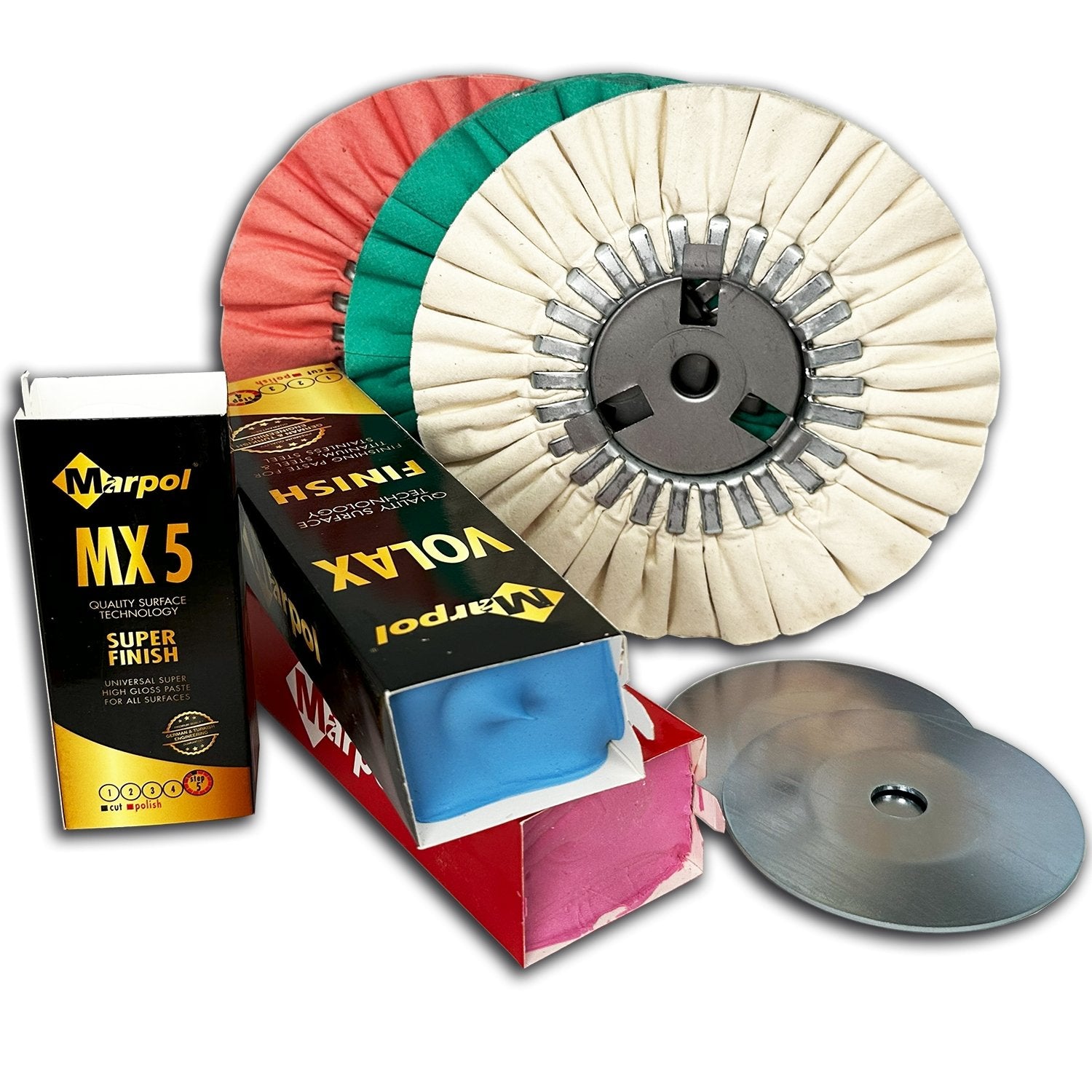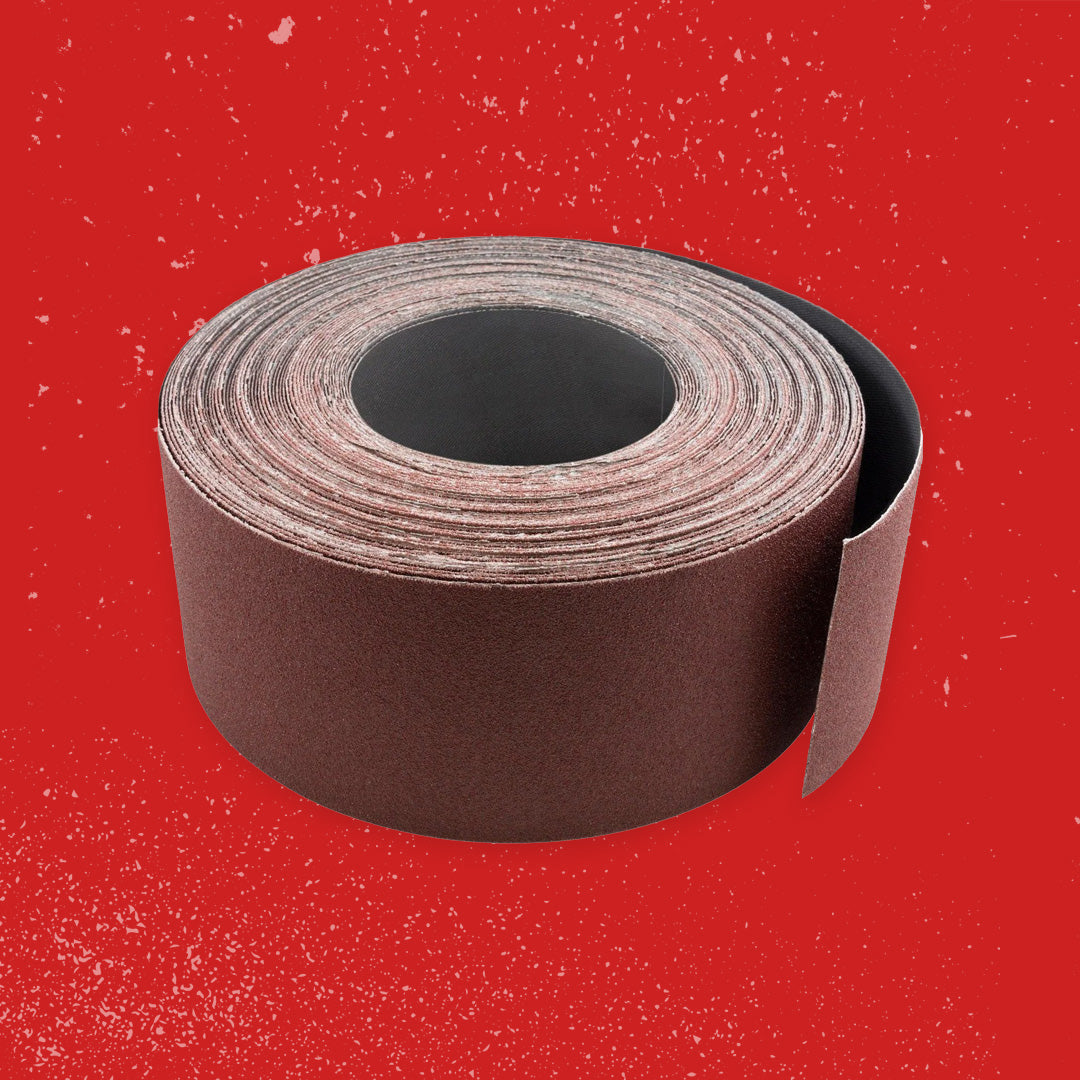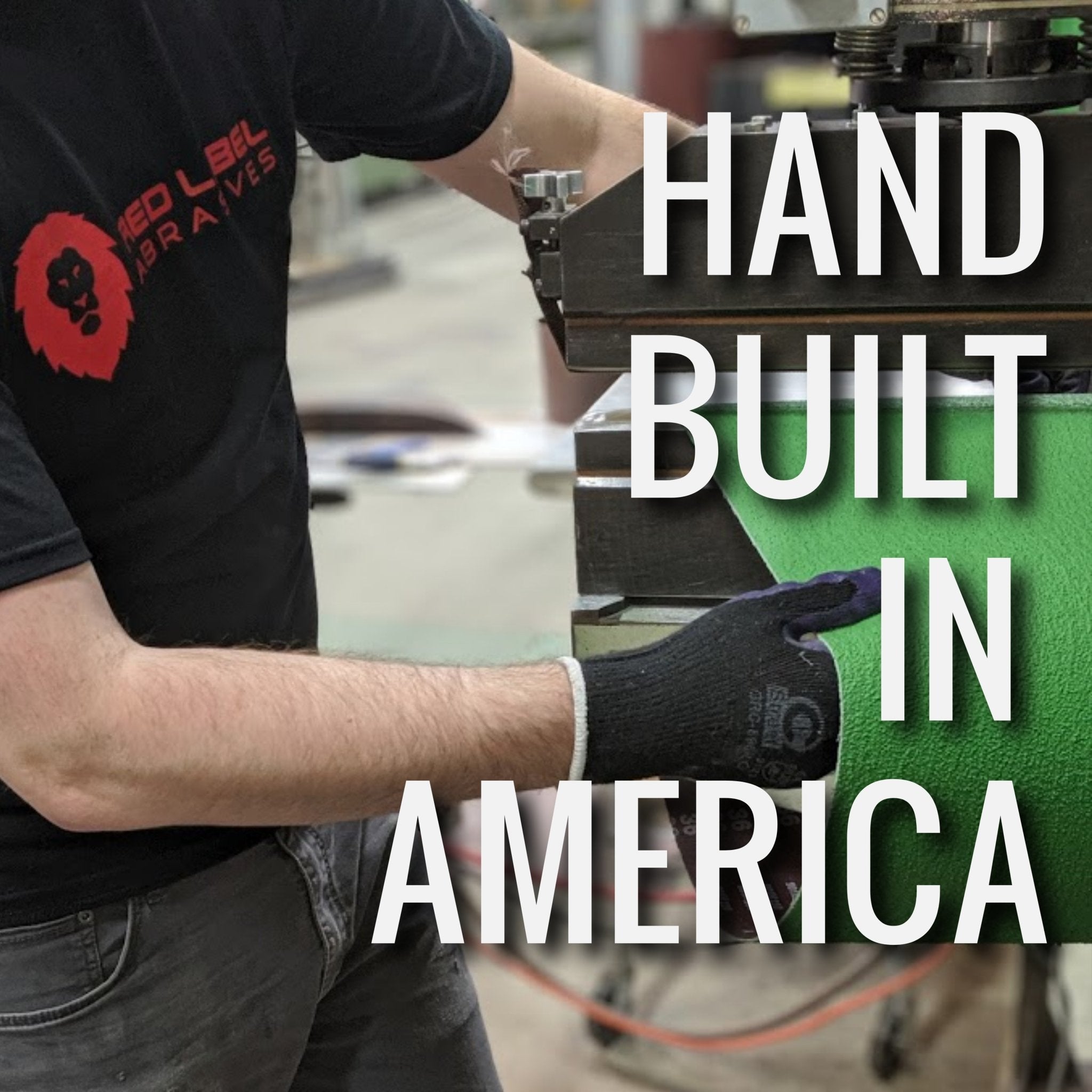Your Cart is Empty
OFFICE CLOSED 11/28 | Free Shipping over $150 (Excludes Oversized Products)
OFFICE CLOSED 11/28 | Free Shipping over $150 (Excludes Oversized Products)
Sanding Belts
Sanding Discs

The Best Sandpaper For Fiberglass: Choosing The Right Product
by David Kranker 9 min read

Quick Summary
Fiberglass is a tough, lightweight material found in boats, cars, and home fixtures. The best sandpaper for fiberglass is typically made with silicon carbide, which cuts cleanly, generates less heat, and performs well in wet sanding. You should begin with coarse grits to shape the surface and gradually move to finer grits (up to 600 or more) for easier finishes between paint layers. Wet sanding is safer and more efficient for fiberglass because it controls dust, reduces heat, and prevents clogging. Power tools like random orbital sanders can speed up large jobs, but they must be used carefully to avoid damage.
Fiberglass is used in a wide variety of industries, including manufacturing, marine, and automotive. It's lightweight yet strong and corrosion resistant, making it ideal for motor vehicle and boat parts, marina components, and even home fixtures like bathtubs and swimming pools.
When you work with fiberglass, you need the right abrasive tools. Unlike materials like wood or metal, there’s little room for error: the wrong abrasive grit or type can result in scratched surfaces, wasted materials, and extra hours of labor. The best sandpaper for fiberglass, on the other hand, makes sanding easier and produces a superior finish that’s ready for coating or painting.
In this guide, the team at Red Label Abrasives will help you select the best sandpaper for your fiberglass projects. We'll cover everything from abrasive types to grit selection, application methods, and practical tips that will improve your results.
What is Fiberglass?
Fiberglass is a composite material made by weaving or matting very fine glass fibers before embedding them in a cured resin. This combination gives it high strength relative to its weight and makes it both chemical and corrosion-resistant, which is why it’s often used in boat hulls, car body panels, and shower stalls.
When you’re preparing fiberglass for painting or finishing, it’s important to remember that the glass fibers are much harder than wood or plastic. The wrong sandpaper will wear out quickly and may clog if the material heats up under friction. At the same time, the fibers can irritate your skin or lungs if they become airborne, so you must wear protective gear. Finally, you should work through a sequence of abrasive grits, starting with a coarser option to shape the surface and moving to finer papers to eliminate scratches and leave a smooth base for primer or paint.
Key Factors in Choosing Fiberglass Sandpaper
The abrasive material itself impacts how well your sandpaper performs on fiberglass. Different minerals and synthetic materials have varying degrees of hardness and cutting ability, so choosing the best sandpaper for fiberglass means taking these details into account.
Choosing The Right Abrasive Grain
Here's an overview of the most common types of abrasives for fiberglass:
-
Silicon Carbide: Silicon carbide is regarded as the best choice for fiberglass. This abrasive cuts quickly, is exceptionally hard, and tends to create less heat during use. When applied correctly, you can get the best results for your project.
-
Aluminum Oxide: Aluminum oxide is a good all-around option that lasts longer than silicon carbide but doesn't cut quite as fast. It works well for general fiberglass sanding and is often less expensive than other premium abrasives.
-
Ceramic: Ceramic abrasives are an excellent premium option for heavy material removal. These abrasives last much longer than other types and stay sharp through extended use. Ceramic costs more upfront but outlasts other options, making it economical for large projects.
-
Zirconia: Zirconia alumina works well on fiberglass because it has the right balance of cutting power and product longevity. These abrasives perform particularly well with power tools due to their heat resistance.
Choosing The Right Grit Size
The grit number on sandpaper indicates the size of the abrasive particles, with higher numbers representing finer grits. Using the grit right sequence helps you achieve a clean finish without damaging your material.
-
Coarse (40-80 grit):These grits are used for initial shaping, removing large imperfections, or stripping old gelcoat and paint. Coarse grits remove material quickly but leave deeper scratches that must be removed with progressively finer grits. They can save you hours of work when dealing with major repairs or reshaping, but require careful handling to avoid digging too deeply into your workpiece.
-
Medium (100-150 grit): Medium grits are ideal for smoothing after coarse sanding as well as removing minor imperfections. They strike a balance between material removal and surface refinement, making them good transitional grits in your sanding sequence. At this stage, you'll start to see the surface becoming more uniform and the deeper scratches from coarser papers beginning to disappear.
-
Fine (180-220 grit): Fine grits are normally used for preparing surfaces before painting or applying gelcoat. They create a sleek surface with enough "tooth" for proper adhesion of finishes. The scratches at this level are barely visible to the naked eye but provide the perfect amount of microscopic texture for primers and paints to bond securely.
-
Very Fine (320-400+ grit):These grits are used for final smoothing between coats of finish or for polishing. When working with clear finishes or preparing for high-gloss applications, these ultra-fine grits help eliminate any visible imperfections and create that glass-like finish many boaters and car enthusiasts seek.
For fiberglass work, you'll normally start with a grit appropriate to the first stage (whether it be shaping or surface preparation), and then progress through increasingly finer ones. Skipping too many grit levels can leave scratches, so a good rule is to never jump more than 50-100 grit numbers in your progression.
|
Grit Range |
Use Case |
|
60–80 |
Removing thick resin or gelcoat |
|
100–150 |
Shaping and fairing |
|
180–220 |
Smoothing and fairing filler |
|
320–400 |
Final sanding before primer |
|
600+ |
Wet sanding between paint layers |
Choosing The Right Backing
When working with fiberglass, you'll need to decide between wet and dry sanding approaches. Each method has its place in fiberglass work, though wet sanding offers particular advantages that include:
-
Reduce dust, which can be harmful if inhaled. The water traps the particles and prevents them from becoming airborne. Fiberglass dust contains tiny glass particles that can cause respiratory irritation and long-term health issues if regularly inhaled.
-
Keep the surface cool. Friction creates heat that can soften the resin, causing the sandpaper to gum up and creating an uneven finish that's difficult to correct. Wet sanding prevents this problem by constantly cooling the work area
-
Wash away debris that would clog regular paper. The slurry created acts as a lubricant, allowing the abrasive to work more efficiently and preventing the paper from getting stuck on the surface.
Look for backings labeled "waterproof" or "wet/dry." Many Red Label Abrasives products, including our silicon carbide sanding discs, are engineered for excellence in wet applications such as fiberglass sanding.
Hand Sanding Fiberglass
Hand sanding fiberglass takes time but it also gives you the control needed for a professional-quality finish. While power tools might speed up the job, hand sanding lets you feel the surface changes and adjust your technique as you go.
Preparation
Before you start sanding fiberglass, gather these supplies:
-
Various grits of wet/dry sandpaper (80, 120, 220, 320, 400)
-
Sanding blocks (rubber or foam)
-
A bucket of clean water
-
Dish soap (a few drops added to water)
-
Sponge and clean rags
-
Gloves, eye protection, and a dust mask
-
Tack cloth for cleanup
Set up in a well-ventilated area; as we explained earlier, fiberglass dust contains tiny glass particles that can irritate your skin, eyes, and lungs. Wearing long sleeves, gloves, eye protection, and a good dust mask is critical.
Basic Hand Sanding Technique
Choose your starting grit based on the condition of the surface. For rough surfaces with imperfections, begin with 80-100 grit. For surfaces in decent shape, start with 120-150 grit. Once you’ve got your sandpaper ready, take the following steps:
-
Dip your sandpaper in water before starting, and keep the surface wet throughout the sanding. This keeps dust down and helps the sandpaper last longer.
-
Wrap your sandpaper around a sanding block for flat surfaces. The block helps distribute pressure evenly and keeps the surface flat. For curved areas, you can use a flexible foam block or just your fingers.
-
Use moderate, even pressure with your palm flat on the sanding block. Let the sandpaper do the work rather than pressing too hard. Excessive pressure can create uneven spots.
-
Work in small sections about 2 feet square. Sand in a circular or figure-eight motion, then switch to straight lines. This helps you avoid missing spots and creates a more uniform finish.
When you’re done, wash the entire surface with soap and water to remove all sanding residue. Rinse thoroughly with clean water and dry with clean, lint-free cloths before wiping it down with a tack cloth to remove any remaining dust. Apply your primer, paint, or gelcoat according to the manufacturer's instructions.
Power Sanding Fiberglass
Power sanding dramatically speeds up work on fiberglass projects, especially larger ones like boat hulls or automotive panels. However, these tools remove material much faster than hand sanding and require careful control to avoid damage to the fiberglass.
-
Random Orbital Sanders: These machines are your best all-around choice for fiberglass. The dual-action motion (spinning and orbiting) reduces swirl marks and provides a cleaner finish. Look for models with variable speed controls and dust collection capability.
-
Finishing Sanders: These rectangular sanders move in a straight-line pattern and work well for flat surfaces. They're good for medium to fine sanding stages but can leave visible scratch patterns that you’ll need to clear away.
-
Detail Sanders: Detail sanders with small, pointed pads help you get into hard-to-reach areas like corners and tight spots.
-
Pneumatic Sanders: If you have an air compressor, air-powered sanders tend to be lighter and more maneuverable than electric models. They're popular in professional shops for their consistent performance.
-
Angle Grinders: For heavy material removal, use an angle grinder with a sanding disc. However, these powerful tools require experience and caution as they can quickly damage fiberglass if not handled properly.
Setting Up Your Tools
Proper setup of your power sanders lets them perform at their best while creating a safer, more comfortable working environment.
-
Choose appropriate backing pads. Soft pads conform better to curves, while firmer pads maintain flatness on straight surfaces. Match your pad firmness to your project's contours.
-
Set the right speed. Lower speeds (1500-2000 RPM) are better for coarse sanding and material removal. Higher speeds (3000+ RPM) work best for fine finishing. Most fiberglass work should be done at medium speeds.
-
Set up water delivery. Some professional sanders have built-in water feeds. Alternatively, you can have a helper mist the surface or use a drip system that applies water to the work area.
-
Connect your sander to a shop vacuum when possible. This dramatically reduces airborne fiberglass dust.
-
Make sure the velcro-style attachment system on your backing pad isn't worn out, otherwise, you risk discs flying off during use.
-
Use proper abrasives. Hook-and-loop discs designed for wet/dry use are ideal. Silicon carbide abrasives generally work best on fiberglass, especially when wet sanding.
Power Sanding Technique
Good technique prevents damage to your fiberglass while maximizing tool efficiency. Learning to let the tool do the work rather than forcing it will give you better results and extend the life of both your sander and abrasives. Recommendations include:
-
Work in an area where water can drain away. For boats or vehicles, consider creating temporary dams with tape and plastic to control water flow.
-
Apply light to moderate pressure only. Pressing too hard doesn't speed up cutting but creates excess heat, damages the surface, and wears out your sander.
-
Never hold a power sander in one spot. Use slow, overlapping passes across the surface. For random orbital sanders, move about 1-2 inches per second.
-
Keep the sanding pad flat against the surface. Tilting or lifting the edge of the pad creates uneven sanding and can gouge the fiberglass.
-
Let the sander follow the natural shape of curved surfaces. Don't try to flatten curves or create new contours unless that's your goal.
-
One hand on the main grip and one on the sander body gives you better control and helps maintain even pressure.
-
Check your work frequently by turning off the sander and feeling the surface with your hand. Look at it from different angles to spot high or low areas.
Pro Tip:Never use standard electric sanders with water. Look for sanders specifically designed for wet operation, typically air-powered (pneumatic) or specialized wet/dry electric models with proper insulation.
Get the Best Sandpaper for Fiberglass at Red Label Abrasives
Selecting the right sandpaper for fiberglass work greatly improves your results. As a general recommendation, silicon carbide waterproof sandpaper provides good cutting ability, finish quality, and value for most fiberglass applications.
Red Label Abrasives has a full line of silicon sanding rolls, sanding belts, sanding discs, and specialty products that produce quality results with fiberglass. For more information or to place an order, call 844-824-1956 or fill out our contact form today.
ABOUT THE AUTHOR
David Kranker is a writer and creative maker who has been covering the abrasive industry on the Red Label Abrasives Blog since 2020. David spends his time continually researching sanding techniques to provide readers with the latest and greatest information. In his free time, David utilizes abrasives for many different home and auto projects at his home in Delton, MI.
Our Most Popular Abrasives

EdgeCore Ceramic Sanding Belts

EdgeCore Ceramic Flap Discs

Buffing Kit
Shop By Product Category





Why Choose Red Label?







